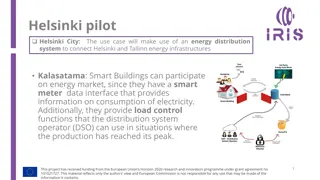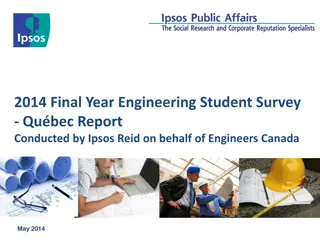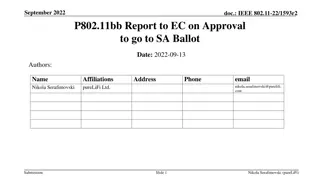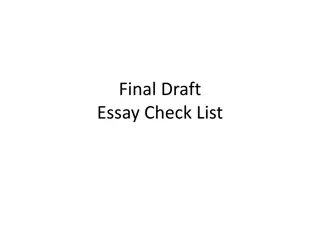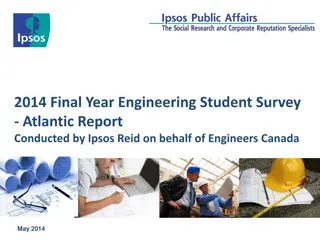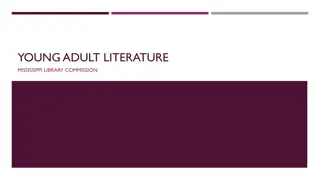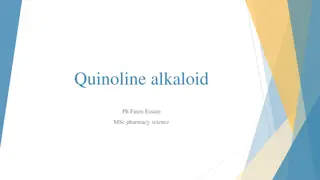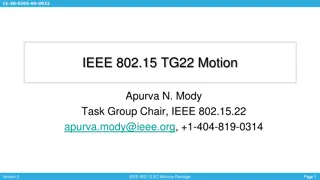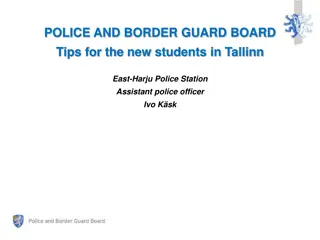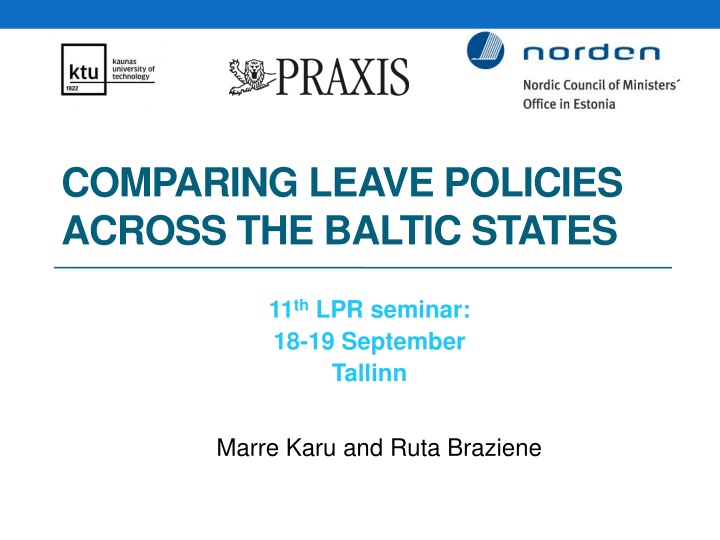
Comparing Leave Policies Across the Baltic States Seminar Insights
Explore the historical and social contexts behind leave policies in the Baltic States of Estonia, Latvia, and Lithuania. Delve into the impact of Soviet history, post-independence reforms, and recent developments. Understand the challenges posed by declining populations and gender equality issues. Discover the similarities and differences in maternity, paternity, and parental leave policies, along with the evolving social and family policy landscape in these countries.
Download Presentation

Please find below an Image/Link to download the presentation.
The content on the website is provided AS IS for your information and personal use only. It may not be sold, licensed, or shared on other websites without obtaining consent from the author. If you encounter any issues during the download, it is possible that the publisher has removed the file from their server.
You are allowed to download the files provided on this website for personal or commercial use, subject to the condition that they are used lawfully. All files are the property of their respective owners.
The content on the website is provided AS IS for your information and personal use only. It may not be sold, licensed, or shared on other websites without obtaining consent from the author.
E N D
Presentation Transcript
COMPARING LEAVE POLICIES ACROSS THE BALTIC STATES 11thLPR seminar: 18-19 September Tallinn Marre Karu and Ruta Braziene
2 What we are going to talk about? 1. Why we compare three Baltic states? Geographical proximity Shared history Same starting-point 2. Social context Demography Employment Childcare Gender Equality 3. Leave policies in three countries Common history of Soviet Union Maternity, paternity and parental leave Concluding remarks and future plans
3 Why do we compare three Baltic states? Experienced the Soviet authoritarian rule 1945-1991 Regained independence in 1990s Processes of democratization Europeanization, globalization etc. Drastic reforms of social policy over a period of 20-25 years Where have 20 years of independent development taken us? Our similarities and differences?
4 Leave policies: common history of Soviet times Assistance for families with children was concentrated on the development of childcare institutions; In theory, state provided many domestic services to free women for employment. In practice not; Guaranteed employment for families with children; oblication to work? Paid maternity leave, which was prolonged continuously to reach three years by 1989 (6 months in 1959; one year in 1982); No right for fathers; Monthly state grants for single mothers were paid up to the child sixteenth birthday.
5 Some characteristics of social and family policy reforms after regaining indepence Male breadwinner ideology; Child-care facilities were cut back (especially in Lithuania); Development of Gender equality mechanisms; And etc.
6 More recent developments Rapidly growing economies in 2004-2007 Recent changes in the period of 2008-2012 Estonia as a Baltic success story
7 Background: Small decreasing populations 4,000,000 3,500,000 3,398,929 3,000,000 2,971,905 Estonia Latvia 2,500,000 Lithuania 2,276,520 2,023,825 2,000,000 1,500,000 1,320,174 1,366,250 1,000,000 2004 2005 2006 2007 2008 2009 2010 2011 2012 2013 In 10 years the population has decreased: Low fertility rate High immigration rate Lithuania by 427,000 (13%) Latvia by 253,000 (11%) Estonia by 46,000 (3,4%)
8 Background: fertility rates below replacementlevels 2.00 1.80 1.72 1.69 1.70 1.72 1.58 1.61 1.60 1.60 1.52 1.58 1.50 1.50 1.56 1.44 1.47 1.54 1.55 1.46 1.37 1.32 1.26 1.46 1.40 1.39 1.45 1.33 1.36 1.29 1.27 1.36 1.33 1.20 1.29 Estonia 1.00 Latvia 0.80 0.60 Lithuania 0.40 0.20 0.00 2003 2004 2005 2006 2007 2008 2009 2010 2011 2012
9 Background: Employment rates by gender (EE, LV, LT) (%) Eurostat, 2013 78 76.7 76 74 71.9 72 71.2 70.1 Males Females 70 68.6 67.7 68 66 64 62 Estonia Latvia Lithuania
10 Background: Baltic States spend quite little on social protection Baltic States spend less on social protection as compared with EU15 and EU27. Baltics on average (2000-2010) 13-19%. EU27 spends 27%
11 There is a CARE GAP! Childcare for childrenless than 3 years by hours, 2005-2012, Eurostat 100% 90% 80% 70% 7472 72 727172 75798182 76 60% 80 818584 8384 8386858484 919087 89 89 9292 95 zero hours 1-29 hours 30+ hours 50% 40% 30% 4 4 2 2 20% 1 2 4 1 1515 14141514 2 1 1 4 2 2 6 2 2 2 1 3 1 21191514 10% 19 1 18 3 9121416 1614 1412131514 1113 13141514 0 911 9 8 6 0 0 5 4 0% 0 0 0 0 2005 2008 2011 2005 2006 2007 2009 2010 2012 2006 2007 2008 2009 2010 2011 2012 2005 2006 2007 2008 2009 2010 2011 2012 2005 2006 2007 2008 2009 2010 2011 2012 EU Estonia Latvia Lithuania
12 Childcare: for children between 3 years and compulsory school age by hours, 2005-2012 100% 8 8 8 8 151413 1917 1716 1617 90% 21 22 6 9 9 10 2926 26 27 4 5 3335 34 36 7 43444139 80% 40 46 48 7 9 6 7 70% 7 3 4040393737 6 9 5 41 9 60% 4 7 7 4 11 9 zero hours 1-29 hours 30+ hours 50% 6 788184 84868383 40% 72 69 68 67 67 66 30% 6056 59 5856 525551 4043 44454746 4647 46 20% 10% 0% 0 0 0 0 0 2005 2009 2005 2006 2007 2008 2009 2010 2011 2012 2006 2007 2008 2009 2010 2011 2012 2005 2006 2007 2008 2010 2011 2012 2005 2006 2007 2008 2009 2010 2011 2012 EU Estonia Latvia Lithuania
14 Maternity leave in the Baltics Duration (cal.days) Payment Ceiling Floor Eligibility Min wage for those who did not work during past 12 months, but worked before All employees incl temporary contracts + self- employed 100% 12 months average 140 None EST flexible 80% Benefit exceeding 925 per month is reduced 50% All employees 6 months average (100% until 2011) 126 70+56 None + self- employed LAT Since 2011 1379 EUR i.e. 3,2x average insured monthly income Since 2010 None Employees or self-employed if insured for 12 months during last 24 months 126 70+65 flexible 100% LIT
15 Paternity leave in the Baltics Duration 10 work days Payment 100% Ceiling 3x average wage Eligibility as for maternity Timing 2 months before or after birth (date) Flexibility Can be divided into parts EST 0% 2009- 2011 80% 10 as for maternity as for maternity 2 months after the birth, In one row LAT calendar days 100% until 2011 100% 28 as for maternity as for maternity First month after childbirth In one row LIT calendar days This is the only leave for only fathers (no quotas) = Estonia and Latvia do not meet the Directive requirement of 1 month.
16 Parental leave in the Baltics Duration Payment Ceiling Floor Eligibility Working parents Until child is 3 yrs old 100% until 1.5yrs 2378 per month 355 if empl history All parents Reduced according to a formula if earnings above 320 eur EST (3x average wage year before las) 38 per month after 320 no empl. history 1,5 years, to be used until child is 8 60% for 1 yr + 43 per month after Benefit exceeding 925 per month is reduced by 50% All employees 30% benefit is paid LAT 142 per month + self- employed OR 43,75% for 1.5 yrs Until child is 3 yrs old 100% up 1yr OR 1,379 per month Insured for 12 months during last 24 months Benefit is paid partly 1st year (reduced if any earnings) and fully 2nd year LIT 142 per month 70% for 1yr + 40% for second yr 3.2 time s average insured monthly income Family entitlement in all countries. Father s take-up around 7% Estonia; 12% in Lithuania
17 Recent changes: MATERNITY PATERNITY PARENTAL EST 2008: 4,25 100% 2009: 100% 0% 2011: 0% 100% 2011 100% 80% No change 2013: working was made more beneficial (benefit is less reduced than before) LAT 2011 100% 80% 2011: Ceiling introduced + working parents get no benefit (before received full benefit) Ceiling introduced Ceiling introduced 2014: 70% 60% Choice: 60% 1yr OR 43,75% 1.5 yrs Working parents receive 30% 2008: 100% for 24 months 2009: 100% for 12 months + 85% 12-24 mnths 2010: Ceiling introduced 90% for 12 months + 75% 12-24 mnths 2011: 100% for 12 months OR 70% for 12mnths and 40% for next 12 months LIT 2010 Ceiling introduced 2010 Ceiling introduced
18 In the Baltics parents (i.e. mothers) take long parental leave 100% below 6 months below 6 months below 6 months 6-12 months 90% below 6 months 80% 6-12 months 6-12 months 70% 60% 6-12 months 50% over 12 months 40% over 12 months over 12 months 30% over 12 months 20% 10% 0% EU 27 Estonia Latvia Lithuania Persons who took parental leave to care for their youngest child aged less than eight, by duration leave (age 15-64), Eurostat 2010
20 THANK YOU FOR YOUR ATTENTION marrekaru@gmail.com ruta.braziene@gmail.com






